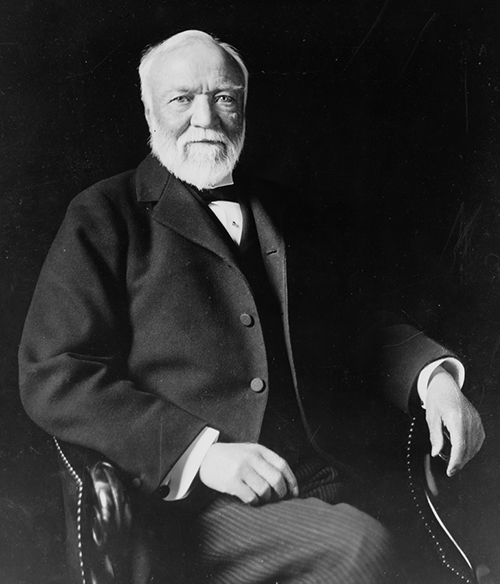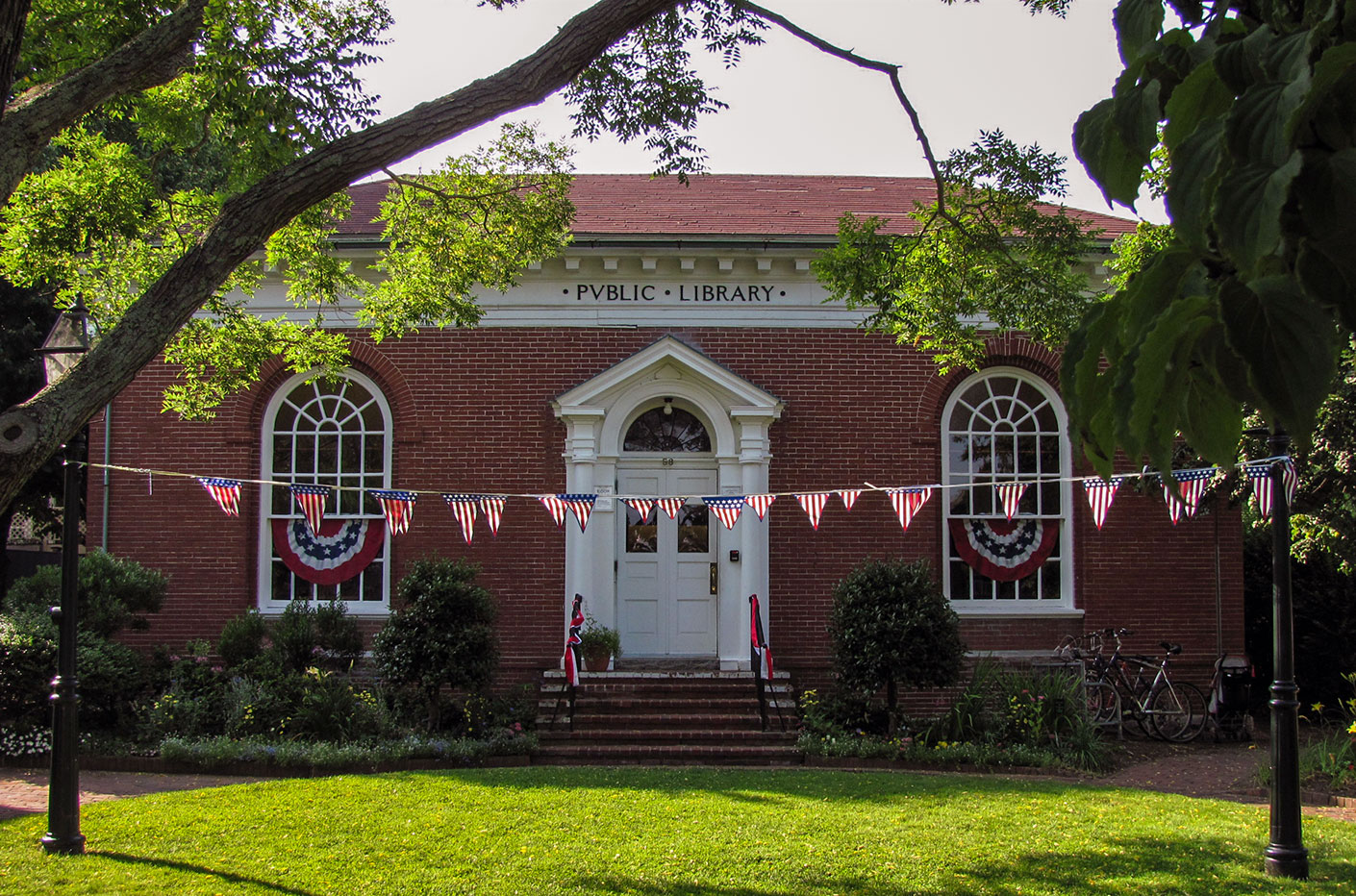The Martha’s Vineyard Preservation Trust recently purchased the 112-year-old Carnegie Library for $1 and Island architect, Patrick Ahearn FAIA has accepted the invitation to help preserve this significant piece of Island history. The executive director of the Trust, Chris Scott, states their intentions with the newly obtained property: to transform the beloved library into a heritage center showcasing the trust’s 24 historic properties on the Island and the “stories they tell about the Vineyard.” To design the library’s future, we must look into its past.
It’s such a great vision. That’s the great thing about this Island — it reflects so many parts of human history. We’ve got it all here, so let’s flaunt it. Let’s celebrate it.
Mr. Stackpole, a maritime historian residing in West Tisbury
The Historical Significance
 Aside from the obvious sentimental attachment to the local library many islanders grew up with, the Carnegie Library has national and local historic significance thanks to philanthropist Andrew Carnegie and Caroline Osborn Warren, a decedent of the prominent Edgartown Osborn whaling family.
Aside from the obvious sentimental attachment to the local library many islanders grew up with, the Carnegie Library has national and local historic significance thanks to philanthropist Andrew Carnegie and Caroline Osborn Warren, a decedent of the prominent Edgartown Osborn whaling family.
At the beginning of the twentieth century, Caroline Osborn Warren donated the current piece of land and Andrew Carnegie gave Edgartown funding for the public library, which was later constructed in 1904. The Osborn family are tied to two other properties owned by the Martha’s Vineyard Preservation Trust: The Desire Osborn House and the Osborn Wharf. Andrew Carnegie built his name and fortune leading the expansion of the American steel industry in the late 19th century. During his final years, he gave away nearly 90 percent of his fortune in efforts to promote his belief in the responsibility of the upper class to use their wealth to improve society. His fortune contributed to the birth of 3,000 local libraries throughout the world as well as the Carnegie Hall, Carnegie Corporation of New York, Carnegie Endowment for International Peace, Carnegie Institution for Science, Carnegie Hero Fund, Carnegie Mellon University, and more.
Over the past century, Edgartown has tried to adapt the older building for modern needs, resulting in two expansions, but it was time to move to a larger facility. The new Edgartown Public Library was an $11 million project and is now located on West Tisbury Road, next to the Edgartown School.

The Future
The Carnegie Library’s past is the precedent for its future. It will continue to be a source of information to maintain its original intended use – which coincides with the trust’s mission with every property they preserve.
“What is a library? A library is a portal into knowledge and being exposed to things, and that will happen here. It will be different, a variation, but the spirit of it is the same. There’s a continuity of mission."
Mr. Stackpole
The Funds
The trust launched a successful capital campaign for the project last year and raised a total of $1.8 million to support the preservation.
The Plan
Patrick Ahearn will be preparing the new plans for the Carnegie Library. The idea is to maintain the original integrity of the exterior and only alter the interior to adapt to its new three main uses:
- Reference Library of Local History
- Visitor Orientation Exhibits
- Gallery of Maritime Art
“I see the interior of the building as being a blank canvas to create a series of wonderful spaces that people can come, enjoy the art, the changing exhibits, grab something quick to eat, and really celebrate all that the trust does for the Island.”
Patrick Ahearn
The front of the building will be dedicated to the library component with a collection of maritime literature, books about the island, and books written by residents. The 1938 and 1970s additions will be used for the exhibits and information about the remaining preservation trust properties and general history.
"The visitor center will become an important tool to educate the public about the Trust and everything they do for the island but, at the same time, it will become a great opportunity for people to host social functions in the building, i.e. plan a party or book a room for lectures, talks on history, architecture, whaling, the harbor…. anything people want to do. It will become part of the community as a whole and for that, I am very excited.”
Patrick Ahearn
Possible Exhibits
Listed are the remaining 23 properties owned by the Martha’s Vineyard Preservation Trust:
- Alley’s Farm Stand
- Before: A garage for a Model A delivery truck
- Now: A farm stand offering local cheese and produce
- Alley’s General Store in West Tisbury (1858)
- Before: A general store
- Now: The oldest operating business on the island
- Chappy Schoolhouse (1850)
- Before: One room school building in New England
- Now: Center for environmental learning for Chappy kids
- Desire Osborn House (1776)
- Before: Home of an owner of a merchant ship transformed later for commercial use
- Now: The oldest commercial structure on Main Street in Edgartown
- Dr. Daniel Fisher House (1840)
- Before: Built by Fisher, a whaling ship owner and one of the wealthiest men in the country at the time and later owned by Senator William Morgan Butler
- Now: Restored to be used as the main offices of the Trust and provides a location for private parties
- The Edwina B. (1931)
- Before: One of only three surviving catboats designed and built by Manuel Swartz Roberts
- Now: Used to educate others about the history of wooden sailboats on the Island.
- The Flying Horses Carousel (1876)
- Before: Built by Charles Dare for Coney Island, NY
- Now: The nation’s oldest platform carousel and a national landmark
- Grange Hall (1859)
- Before: The location for the Agricultural Fair
- Now: The location for farmers markets, fairs, and antique sales
- Hilly’s Garden (1899)
- Before: An accurate restoration based on photographic documentation of the “Sunken Garden” installed by Senator Butler
- Now: Named in honor of Hillary Luther, an avid Edgartown gardener
- John Coffin House (1703)
- Before: Originally built for a prosperous mariner, the house was also for many years a tavern and inn
- Now: The oldest commercial structure on North Water Street in Edgartown housing a number of retail businesses
- Nathan Mayhew Schoolhouse (1828)
- Before: The Island’s oldest one-room schoolhouse
- Now: The Morgan Learning Center, a seasonal educational space for the Martha’s Vineyard Museum
- The Norton Boathouse (1840)
- Before: The waterfront headquarters of Norton sea captains. The Nortons were among the first settlers of Edgartown in the 1640s.
- Now: The last sea captain’s and fisherman’s boathouse on the harbor
- The Old Sculpin Gallery (1840)
- Before: Manuel Swartz Roberts, reffered to as “Old Sculpin” operated his wooden boat shop there for 50 years
- Now: The Martha’s Vineyard Art Association continues to operate their non-profit gallery and educational programs in the building
- Old West Tisbury Library (1870)
- Before: Built by Moses Mitchell as part of the Mitchell Boys School Campus and serviced as the town library for over fifty years
- Now: Home to the Island Theatre Workshop
- Old Whaling Church (1843)
- Before: Designed by Fredrick Baylies, Jr.and built by Edgartown’s prosperous Methodist whaling captains
- Now: This building is one of the finest examples of Greek Revival architecture in New England. The Methodist congregation continues to use it and it also serves as a venue for Town Meeting, weddings, lectures, concerts and other civic events.
- Osborn Wharf (1840)
- Before: It was originally a warehouse for goods shipped by the Osborne family, prosperous 19th Century ship owners
- Now: it remains in maritime use as the chandlery of Martha’s Vineyard Shipyard making it the oldest commercial structure on the Edgartown waterfront
- Peabody Gazebo (1840)
- Before: Originally located at the Peabody estate, Glen Magna Farm, in Danvers, Massachusetts
- Now: Admired by all Islanders
- Slip Away Farm on Chappaquiddick (1790)
- Before: A rare surviving example of a New England Half-Cape
- Now: The land continues to be used for agricultural production and is home to the Chappy Schoolhouse
- Union Chapel in Oak Bluffs (1870)
- Before: Built as a non-sectarian place of worship
- Now: Union Chapel has long been a favorite venue for concerts, recitals, political meetings, speakers and wedding ceremonies
- Village Green (1642)
- Before: The center of Edgartown’s original village settlement
- Now: A small park connecting four in-town commercial streets
- Vincent House Museum (1672)
- Before: The Island’s oldest residence
- Now: A museum dedicated to life on the Island
- Vineyard Gazette Building (1760)
- Before: Originally constructed as a residence
- Now: The production headquarters of the Island’s oldest newspaper
- West Garden (1890)
- Before: Created by Senator Butler
- Now: Admired by the public